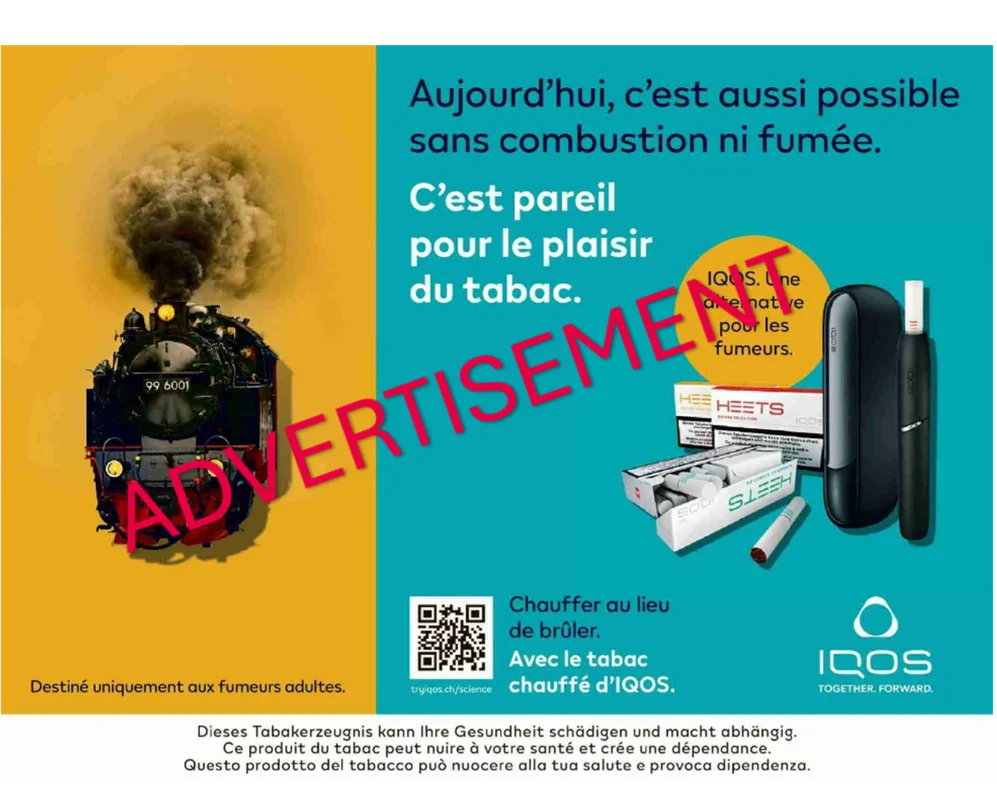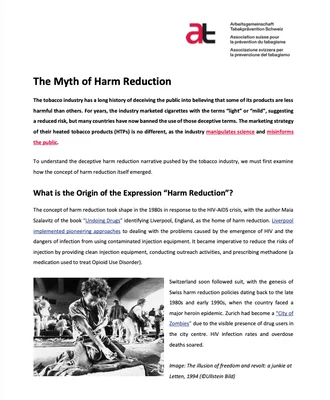- 28.08.2025
- News
- Blog
The Myth of Harm Reduction
The tobacco industry has a long history of deceiving the public into believing that some of its products are less harmful than others. For years, the industry marketed cigarettes with the terms “light” or “mild”, suggesting a reduced risk, but many countries have now banned the use of those deceptive terms. The marketing strategy of their heated tobacco products (HTPs) is no different, as the industry manipulates science and misinforms the public.
from Malgorzata Posoch, Kris Schürch and Luciano Ruggia
To understand the deceptive harm reduction narrative pushed by the tobacco industry, we must first examine how the concept of harm reduction itself emerged.
What is the Origin of the Expression “Harm Reduction”?
The concept of harm reduction took shape in the 1980s in response to the HIV-AIDS crisis, with the author Maia Szalavitz of the book “Undoing Drugs” identifying Liverpool, England, as the home of harm reduction. Liverpool implemented pioneering approaches to dealing with the problems caused by the emergence of HIV and the dangers of infection from using contaminated injection equipment. It became imperative to reduce the risks of injection by providing clean injection equipment, conducting outreach activities, and prescribing methadone (a medication used to treat Opioid Use Disorder).
Switzerland soon followed suit, with the genesis of Swiss harm reduction policies dating back to the late 1980s and early 1990s, when the country faced a major heroin epidemic. Zurich had become a “City of Zombies” due to the visible presence of drug users in the city centre. HIV infection rates and overdose deaths soared.

Ullstein
Image: The illusion of freedom and revolt: a junkie at Letten, 1994 (©Ullstein Bild)
The Success of Harm Reduction Policies Towards HIV in Switzerland
As part of their “four pillar model”, including prevention, treatment, harm reduction, and law enforcement, Switzerland was able to address the heroin epidemic in a comprehensive and humane way. The direct and indirect harm associated with heroin use was reduced at a population-wide level and played a key role in decreasing the incidence of HIV by 88% in Switzerland.

aids.ch
Figure: HIV positive laboratory reports, by gender and test year since the start of testing, 1985 – 2023. Source: aids.ch
Additional global success stories of effective harm reduction strategies for public health include:
- Prescribed opioid agonist therapy has been shown to reduce the risk of drug-related death in Scotland.
- Drug Consumption Rooms in Sydney and Vancouver, also known as supervised injection facilities, can significantly reduce the risk of fatal overdoses.
- Needle and syringe programmes having the highest impact in HIV prevention in the US.
Harm Reduction International defines harm reduction as a complex intervention that requires the comprehensive implementation of policies, programmes, and practices. This approach of harm reduction, which is adopted by public health authorities, is based on principles of justice and human rights, focusing on positive change and working with people without judgement, coercion, or discrimination.
In contrast, the tobacco industry’s way of using harm reduction is by simply replacing one harmful product with a different harmful one. It manipulated the concept of harm reduction to fit its promotional strategy. By advertising their HTPs under the guise that they are “safer”, the industry attempts to attract new users.
How the Tobacco Industry Co-Opts “Harm Reduction” to Sell its Products
Tobacco companies are aware of their loss in public credibility after suffering devastating blows to their public image in recent decades.
As part of the tobacco industry’s efforts to resuscitate its image, the industry has lifted and misappropriated the concept of harm reduction from the public health domain in order to justify the production and to promote the sale of their HTP.
HTPs are one of their latest flagship products and first appeared on the Swiss market in 2015. Since then, the tobacco industry has invested significant resources in selling the illusion of their HTPs being less harmful and misleadingly describing them as “smoke-free products”.
Image description: IQOS advertisement in French-speaking media in Switzerland, which says:
“Today, it's also possible without combustion or smoke.”
“The same goes for the enjoyment of tobacco. IQOS: An alternative for smokers.”
“QR Code – Heating instead of burning. With IQOS heated tobacco.”

One of the major international tobacco companies, Philip Morris International (PMI), has been particularly active in promoting its HTP IQOS/ILUMA, going so far as to manipulate and buy science.
In one example often referenced by the industry to support their claim that HTPs are 95% less harmful than traditional cigarettes, PMI set up and financed the Foundation for a Smoke-Free World, which published an article to make these claims.

Image: Examples of advertising for IQOS exploiting the “95% myth”
Shiro Konuma, a former Philip Morris employee, now whistleblower, has confirmed that:
“No independent studies have shown IQOS is healthier. You have to look at who’s funding it.”
These misleading tactics are similarly applied by supporters of e-cigarettes as a harm reduction tool. For instance, an article published in the journal European Addiction Research estimated a 96% reduced risk for smokers to use e-cigarettes instead of traditional cigarettes. The article lacked tangible evidence, was funded by the industry, and was written by David Nutt, Martin Dockrell, Karl Fagerstrom, and Riccardo Polosa, who have been found to have direct ties to the industry. Essentially, the concept of 95% reduced harm is a myth. The tobacco industry’s theory of “harm reduction” is distorted and poses a public health concern on many levels, as echoed by the European Respiratory Society.
For public health, ethical considerations and the reduction of socio-health-related burdens caused by tobacco products are the impetus for harm reduction. In contrast, the tobacco industry's driving motives are profit maximisation. Therefore, these two approaches are mutually exclusive.
“Heated tobacco products, regular tobacco smoking, and smokeless tobacco for oral or nasal use are all addictive and carcinogenic to humans. We should not allow debate around the new tobacco products to distract us from the main job at hand – promoting regulatory measures that we know are effective at reducing smoking and continue to support those who wish to quit smoking.”
Prof. Charlotta Pisinger on behalf of the European Respiratory Society
The Heart of the Matter
Heated tobacco products are not safer alternatives to cigarettes and there is no such thing as a safe level of exposure. There is no evidence either that HTPs help in smoking cessation. On the contrary, there is an additional risk that smokers will become dual tobacco users by switching from traditional cigarettes.

